The best compression socks for varicose veins will usually adequately cover your damaged blood vessels and provide a compression level of between 15 and 50 mmHg, depending on severity.
Your doctor can give you personalized advice, but cases usually improve with the use of knee-high compression gear with mid-level pressure (20-30 mmHg).
If you have varicose veins, you have probably heard the term “compression socks” thrown around, but maybe you’re not quite sure what they are or what they do.
Or maybe you know what they are but aren’t sure which ones would be the most suitable for your condition.
After arming you with some general knowledge about the vascular diseases they can help address, we’ll even give you our recommendations for four of the best ones for your varicose veins.
What are compression socks?
Compression socks are exactly what they sound like – garments that compress your lower limbs. Made from stretchy material such as cotton, wool, or synthetic fabrics, they are snug-fitting and designed to exert pressure onto the lower legs.
They are used for various conditions, including preventing deep vein thrombosis or promoting healing after surgery.
The search (and choices) for these garments can be endless, and to address this dilemma, we’ll narrow down your choices by giving our recommendations on the best compression sock for varicose veins.
But first, we need to make sure that we understand what varicose veins are and how compression socks can help.
What are varicose veins?
They are definitely bad — and can be painful!
Varicose veins are a medical condition of the circulatory system and usually prevalent in the lower extremities. They appear as swollen, enlarged veins that typically occur on the feet and legs.
The cause of these bulges is due to damage to the tiny valves inside the veins, which is often hereditary. When these fail to function properly, blood will flows backward and collects in pockets, causing swelling and a knotted look.
They usually appear blue, purple, and green, tending to bulge out more than normal veins do. They’re unsightly and may be painful, often occurring with muscle cramps and a burning sensation in the affected area. For some people, the symptoms and pain can be worse during warmer weather.
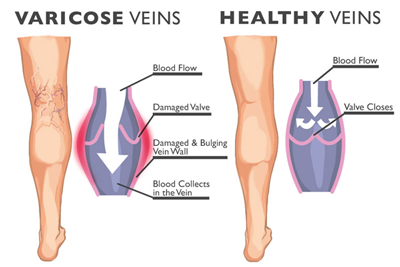
Go and see your doctor
People who experience varicose vein discomfort are likely to be driven to seek medical attention. Many find it surprising that doctors initially prescribe wearing compression socks, a form of therapy, to treat the disease and frequently recommend wearing them from morning until night.
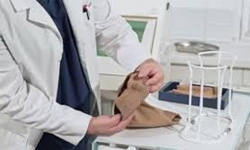
Your physician may also encourage you to engage in more physical activity that promotes better blood circulation, general fitness, and overall health.

What causes them?
Under normal circumstances, as part of our blood’s circulatory process, the heart pumps blood through the arteries to provide oxygen and other essential nutrients to every part of the body. The process ends with the blood flowing back to the heart through the veins.
Once your blood reaches your legs, however, your heart has to work very hard against gravity to pump blood back to the heart via the veins.
In healthy veins, valves within them act as stoppers to keep the blood from flowing back down to your lower limbs due to gravity.
Damaged valves
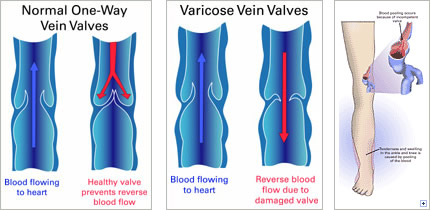
When your veins’ valves are broken, thin, or otherwise compromised, however, they begin to allow blood to flow back down and pool in certain areas, causing their swollen and knotty appearance. This condition is known as venous insufficiency, a.k.a. varicose veins.
Typically, these problems happen more in your lower limbs than anywhere else in your body because of gravity.
Moreover, your legs’ veins are typically much larger than they are in other parts of the body, making them more susceptible to pooling blood.
How compression socks help you
As you can probably imagine, these bulging veins can be an eyesore and can also be painful.
One of the most effective and affordable ways to treat this condition is by wearing a type of compression gear. These garments work by providing external pressure to keep the valves intact, promoting proper blood circulation from the legs back up to the heart.
A majority of compression socks are graduated. This means there is more pressure at the ankle, and the pressure decreases further up along the leg. The tightness at the ankle region works to counter the effects of gravity.
How do they actually help?
Here’s a simple way to explain how these garments work.
Due to their graduated nature, with stronger pressure at the ankles and reduced pressure further up along the legs, they can actually help your blood to flow back upwards toward the heart.
Effectively, these garments enhance the blood flow from the legs to the heart, allowing freshly oxygenated blood to circulate from the heart to the legs via one’s arteries.
Ultimately, compression socks help the blood during its journey back to the heart and against the force typically exerted by gravity. Using them can also help prevent associated diseases from developing! Meanwhile, those that already have damaged or compromised veins can benefit from wearing them since they may reduce the pain and discomfort caused by the damaged valves.
Improve blood circulation

Compression legwear not only helps to improve blood circulation; they also reduce the formation of new varicose veins. People at higher risk for varicose veins may choose to wear them as a precautionary measure against the disease.
It is essential to highlight, however, that wearing them will not eradicate existing varicose veins. However, they can certainly help to relieve symptoms and reduce the negative impact of the disease on your life.
Are there risks when using compression socks?
The great news about utilizing them is that they are risk-free! Properly wearing these garments will not result in any difficulties or complications.
However, keep in mind to wear ones that fit well to avoid unwanted problems.
For example, ill-fitting ones could cause skin irritation or redness. If they’re too tight, they can also limit blood circulation — the exact opposite of your desired effect.
What to watch out for
If you wear these garments, examine your legs daily and check for signs of redness or irritation. Consult your doctor if a problem persists. While this could simply mean you need a different size, it might be indicative of another problem.
Under normal circumstances, it is totally safe to wear them. However, people with conditions such as PAD (Peripheral Artery Disease), CAF (Congestive Heart Failure), massive edema, skin infections, or open wounds of any kind should not be wearing them. At the very least, consult a doctor before you start any form of compression therapy.
Now that you understand what these garments can for you, let’s take a look at those recommendations!
Choosing the right one for you
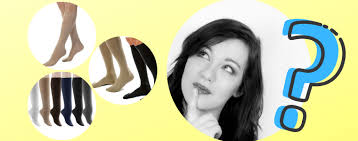
It can be an immense task choosing the right compression socks for your varicose veins because you’ll have plenty to choose from. Usually, however, the items vary in just two ways: the length of the socks and the level of compression pressure. Of course, you can choose from a variety of designs and materials!
Most compression socks reach the knee area, but other types can go all the way past the knees, which exerts more pressure on the leg. Some companies even market them in the form of full-length pantyhose.
To determine the appropriate length for you, first consider the area wherein your varicose veins have developed.
Most people develop the disease in their lower legs or their calves simply because of the effects of gravity. For this reason, knee-length ones are usually the most effective.
Besides the length, another consideration in your choice would be the strength or level of compression of the garment. This is measured similarly to how your blood pressure cuff measures your blood pressure in mmHg or millimeters of mercury.
Typically, a garments’ strength can range from 8mmHg to 40mmHg.
So, which ones are the best for you? We’ll save you some research time so check out our recommendations!
1. ComproGear Savory Blue Knee High Socks
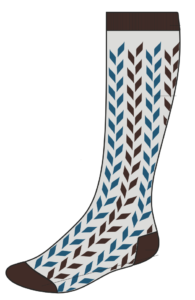
This is a graduated compression sock with a range from 20-30mmHg. Perfect for pesky varicose veins!
This pair comes in a rich blue color and a fun, stunning design. Made with a combination of 65% nylon and 35% Spandex, it’s super comfortable!
These socks are designed to hug your leg tightly all day and reduce the expansion of your veins. They’re also appropriate for athletes recovering from athletic injuries.
And, in stark contrast to the old-fashioned brands that might still be scratchy and uncomfortable, these are excellently built to give maximum comfort and ease.
2. ComproGear Sunset Stripes Knee High Compression Stockings
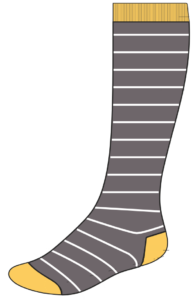
Give yourself a happy little boost in the morning each time you put on this pair. They come in an irresistible “sunset stripes” design – guaranteed to lift your mood!
With a compression level of 20-30mmHG, you can be confident that your varicose veins are well-managed and complications are kept at bay. Made with 65% nylon and 35% spandex and designed with your comfort in mind, your legs will get to breathe all day long.
3. ComproGear Knee-length Mountain Blue Hose
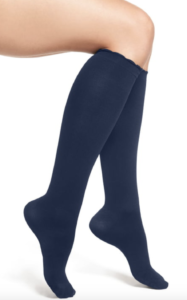
This is a stylish, classic choice for women. Perfection!
This pair of compression socks aren’t just beautiful; they’re also built to last.
The compression level for this pair is from 20-30mmHg, excellent for preventing and managing your varicose veins. Made with 65% nylon and 35% spandex, they’re very comfortable, and washing and drying them is a breeze.
4. Comprogear Onyx Knee High Black Hosiery
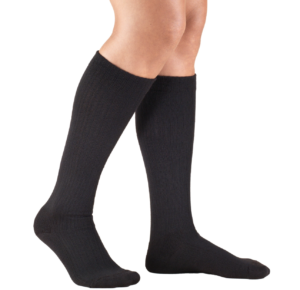
Just like your perfect little black dress, this little black pair can take you from everyday use to formal wear.
Be confident and take comfort in the thought that this pair will work for every occasion. They offer a compression level that ranges from 20-30mmHg and makes wearing and removing an easy task.
Made of 35% spandex and 65% nylon material, it has moisture-wicking properties and provides comfort throughout long hours of wear.
Reasons to Choose ComproGear Compression Socks
Still unconvinced or undecided that ComproGear brands are right for you? Consider these factors in your purchase decisions!
- The Guarantee – Each pair of compression socks you purchase from the Comprogear website is backed with a 100% guarantee policy. If the items you received don’t feel like they’re the right size, don’t panic. Just let us know, and we’ll replace them with a pair tailor-fit to your specifications.
- Best Sizing- Unlike some companies that offer “one-size-fits-all,” ComproGear provides various sizes for each pair of compression socks. You get the right pair that’s tailor-fit to your needs!
- Return Policy- If you still can’t find the right size, your money will be refunded without delay or charges.
Tips to make your purchases work for you
To get the most effective results, you’ll need to wear your compression socks properly. Now that you’ve purchased one of the recommendations we made — four of the best ones out there — here are a few more tips to make your purchase work for you.
Keep these in mind:
- Compression socks should not feel overly tight on the legs. Ideally, the socks should feel snug but not too constricting.
- Although there will be an adjustment period, monitor your results while you wear your socks.
- If, after a few days, you still don’t feel any change, you may need to change the strength or level of compression.
- For the best results, wear your socks all day. Start as soon as you wake up and wear them until you go to bed.
- Most people do not need compression socks while sleeping. At this time, your legs are already elevated and this lets your legs rest and breathe.
- Sometimes, however, your doctors will instruct you to wear compression socks to bed. Follow your doctor’s advice for the best and most effective results.
The Takeaway
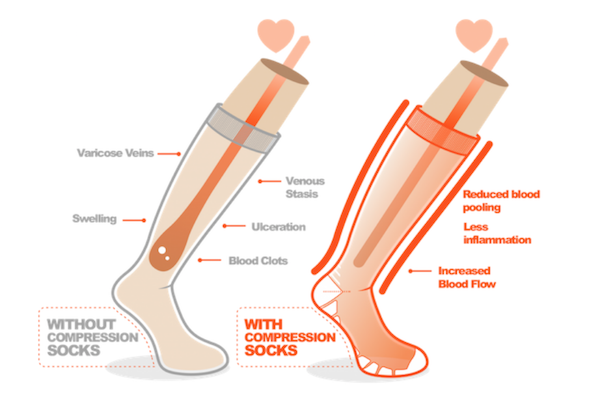
While it is generally safe to wear them, compression socks and gears should not be used indiscriminately. “Regular folks” who need them most are nurses and other medical staff, athletes and runners, office workers and people who sit all day, and those recuperating from surgery. Wearing the garments for these people should generally be risk-free.

When you do wear them, be sure to use them properly. Check with your doctor especially if you’re wearing them for medical purposes.
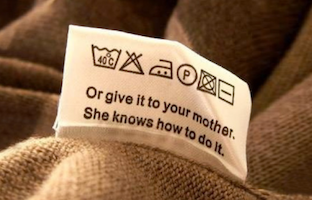
To save you the hours you need just for research, we gave recommendations for four of the best ones out in the market, so get yourself a few pairs with just a few clicks. Your feet and leg will thank you!
Lastly, prevent the elastic fibers from damage and make them last a long time. Read all about the proper care of your garments here.
